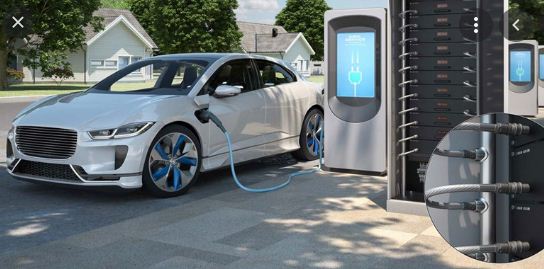Sundas Khalid
Abstract:
The wind energy enhanced electric vehicle is one which includes multiple generators/turbines according to the user demand which will be powered by the aerodynamics of the car to charge the battery and provide extra miles on the same charge.
Future of EV is evolving and it is predicted to see its peak in near future, future is all electric and soon EV’s will replace gasoline engine. Electric cars are expensive and developing but the problem sustains; range limitation. However mid-priced electric vehicle class has limited features with less emphasis on features like infotainment, instrument cluster, and other expensive features. Considering the future and ease of EV users, our idea of range extension is a must for every user in future, it has a huge market capacity and may bring ample revenue in future.
Introduction:
The idea is an add on to pre-existing electric cars.On averagean electric car ranges around 250km (variable) range in single charge. With this idea one can increase range of his electric vehicle without breaking his pocket.We are introducing wind turbine assistedgenerators for electric cars positioned in front grills and bumper, the process can be simply quoted as,the propeller shaft is attached to generator shaft with the gear system in-between. The cars aero dynamics would assist the rotationof the propeller, the gear system would amplify the revolution and the generator will produce energy that will compensate the actual range.
The electric vehicle has been around for over 100 years, and it has an interesting history of development that continues to the present. France and England were the first nations to develop the electric vehicle in the late 1800s. It was not until 1895 that Americans began to devote attention to electric vehicles. Many innovations followed and interest in motor vehicles increased greatly in the late 1890s and early 1900s. In 1897 the first commercial application was established as a fleet of New York City taxis. The early electric vehicles, such as the 1902 Wood’s Phaetonwere little more than electrified horseless carriages and surreys. Since the invention of electric car, it has been developed till date. Despite this fact, the major challenge which is their short driving range still exists.
Electric Car driving system constitute of 3 major components; namely, the motor, the controller and the battery (Annexure. 1)(Raj, n.d.). While some cars would use the standard car batteries as a source of energy, the more advanced ones use the Li-ion batteries as more efficient energy source that gives extra range of operation for the vehicle. They not only are capable of fast charging but they provide more energy to the motor attached. Additionally, the controller is very important as it synchronizes the operation of both motor and battery. Moreover, electric car chargers are responsible for charging the battery pack in an electric car. These chargers are installed in homes, offices, shopping stores and public places to enable one to charge his/her car. Fully charging an electric car can take 6-8 hours.
The idea of adding a wind turbine generator is to extend the existing range on an electric vehicle whilst consuming the already estimated range. Getting a car with longer range is yet possible but, electric cars are very expensive as they consist of various software and hardware advancements which are yet under constant development.
For instance, Tesla Model S Plaid with an estimated range of 350miles is for 113000$ excluding taxes and the Plaid+ model which has an estimated range of 550+miles, is for whopping143000$, excluding taxes. One has to pay an additional 30000$ for range extension, which on the other hand can get you a normal sedan. We represent the idea of range extension using wind energy which is going to charge the battery to some extent to ensure extra miles on the same charge.
Discussion:
If a normal range electric car with an efficiency of 295Wh/mile is driven 13500 miles a year, a total of 3,982,500Wh of energy is used, which is equal to 3,982.5KWh. On average KWh in United States is charged at rate of 0.13$, which equals to a total of 517.73$ to drive the car over a year, breaking it to months it will cost around 43.14$(Sibila).A range extended vehicle would cost slightly more on monthly basis.
The Electric Vehicle Market is projected to reach 26,951,318 units by 2030 from an estimated 3,269,671 units in 2019, at a CAGR of 21.1% during the forecast period.Mid-Priced vehicle segment are expected to grow at highest CAGR rate(Marketsandmarkets, n.d.). The future of EVs is expected to be bright and with time the price of batteries, one of the most vital components in an EV, is reducing significantly which would make EVs more affordable. Mid-Priced vehicle class has limited features with less emphasis on features like infotainment, instrument cluster, and other expensive features. In July 2018, Great Wall Motors announced a partnership with BMW Group to produce electric MINI vehicles in China. In December 2018, the company launched its new flagship vehicle under its new ‘ORA’ electric car brand: the ORA R1. The small urban car will cost only USD 8,680 after incentives with a range of almost 200 miles, the problem still sustains; short range for mid-priced EV’s.
Air pollution is a big issue in the cities for developing countries. Air pollution is mainly caused by vehicle emissions. Electric cars have zero emission. Using electric cars should not hurt economy. Oppositely, the business of electric cars can create a lot of jobs in the areas of new electricity charge station construction and operation, battery production, renewable energy, new car design, and production. Electric cars and vehicles have low emissions (zero emission by using renewable energy) and can become integral parts of a smart grid, where they do not just consume power but also provide mobile storage of energy.Target audience for our product is middle class, someone who can spend 100k$+ for an EV, can easily spend over 130k$ for a long-range EV. Considering the future and ease of EV users, our idea of range extension is a must for every user in future, it has a huge market capacity and may bring ample revenue in future(Liu).
For better understanding, let’s take example of 2 electric cars, Car X and Y, both of the cars are identical and both has stock batteries and motors, except car Y is equipped with our wind energy generator. The trip is from point A to point B.
For instance, both cars accelerate at the same pace, Car X would complete 3 quarter, whereas Car Y would complete its trip to point B (Annexure. 2).
If one has to complete his trip from point A to B, he has to have his hands on long range electric vehicle which as aforementioned has quite large price difference. A similar representation of our idea (Annexure. 3) (Prem, n.d.)shows how we can add wind energy generators in front end of the car. Similarly, we can adjust multiple generators in different positions of the car e.g. front bumper, bonnet grill, inside the frunk, rear bumper and grills.
The aerodynamics of the car running in forward direction would assist the propeller of each generator/turbine to rotate, the gear system which is attached to the propeller shaft and the generator shaft would amplify the rotation significantly, providing more efficiency even if car moves at a slow speed. 5 to 6 turbines installed according to the need of user can produce sufficient power to charge the battery. The generators will then act as a charger and help charge the EV battery while using it simultaneously. It will provide the user with additional miles on the same charge he had done while departing for his journey. (Annexure. 4)
Conclusion:
1) Wind energy is a renewable and never-ending source of energy.
2) Electric Cars is the future of automotive industry.
3) All development in automotive industry has led to better vehicles gradually.
4) The only problem that still exists is shorter range.
5) The EV’s with bigger batteries are too expensive to afford for a middle-class user.
6) Wind energy enhanced vehicles would help users get extra miles on the same charge without breaking their pockets.
7) Wind energy enhanced vehicle is a cheap alternative to longer range electric cars.
8) Wind energy enhances vehicles is easy on monthly bills also.
9) Wind energy turbines is a deal breaker for both mid-priced and high-end electric vehicles as it compensates that extra amount for bigger batteries.

















